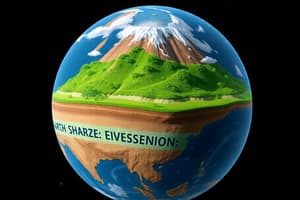Podcast
Questions and Answers
Which subsystem of Earth includes all living organisms and the abiotic factors that provide them with energy and nutrients?
Which subsystem of Earth includes all living organisms and the abiotic factors that provide them with energy and nutrients?
- Atmosphere
- Geosphere
- Biosphere (correct)
- Hydrosphere
What is the primary component of the atmosphere that constitutes the largest percentage of its composition?
What is the primary component of the atmosphere that constitutes the largest percentage of its composition?
- Carbon Dioxide
- Argon
- Nitrogen (correct)
- Oxygen
What is the process called that redistributes the heat of the Earth within the atmosphere?
What is the process called that redistributes the heat of the Earth within the atmosphere?
- Atmospheric circulation (correct)
- Geothermal circulation
- Thermal stratification
- Oceanic current movement
Which of the following is NOT a criterion for a substance to be classified as a mineral?
Which of the following is NOT a criterion for a substance to be classified as a mineral?
What percentage of Earth's water is classified as fresh water?
What percentage of Earth's water is classified as fresh water?
Which layer of the Earth is primarily responsible for creating the planet's magnetic field?
Which layer of the Earth is primarily responsible for creating the planet's magnetic field?
Which component of the Earth is described as the 'solid, outer part' that includes the crust and upper mantle?
Which component of the Earth is described as the 'solid, outer part' that includes the crust and upper mantle?
Which of the following accurately defines the hydrosphere?
Which of the following accurately defines the hydrosphere?
What measures the resistance of a mineral to abrasion?
What measures the resistance of a mineral to abrasion?
Which term describes the quality and intensity of reflected light from a mineral?
Which term describes the quality and intensity of reflected light from a mineral?
Why is streak considered a better diagnostic property than color?
Why is streak considered a better diagnostic property than color?
What geometric characteristics are described by crystal form/habit?
What geometric characteristics are described by crystal form/habit?
What is cleavage in mineralogy?
What is cleavage in mineralogy?
Which of the following best describes the Mohs Scale of Hardness?
Which of the following best describes the Mohs Scale of Hardness?
Which of the following is NOT a type of non-metallic luster?
Which of the following is NOT a type of non-metallic luster?
What type of fracture does Quartz commonly exhibit due to its crystal structure?
What type of fracture does Quartz commonly exhibit due to its crystal structure?
Flashcards are hidden until you start studying
Study Notes
Earth's Subsystems
- Earth is a system composed of four interrelated subsystems: biosphere, atmosphere, hydrosphere, and geosphere.
- Energy and matter are constantly flowing between these subsystems.
Biosphere
- All living organisms and their abiotic environment that provides energy and nutrients.
- Extends from the atmosphere to the deep sea vents of the ocean.
Atmosphere
- Thin, gaseous layer surrounding Earth.
- Composed primarily of nitrogen (78%), oxygen (21%), argon (0.9%), and trace gases.
- Atmospheric circulation redistributes heat from the sun.
Hydrosphere
- 70% of Earth's surface is covered by water.
- 3% is freshwater, two-thirds of which is ice.
- Regulates heat on the Earth's surface.
- Ocean circulation moves heat around the globe.
Geosphere
- Earth's solid surface, interior, rocks, minerals, and landforms.
- Includes processes that shape Earth's surface.
Geosphere: Internal Structure
- Mantle:
- Upper mantle: less dense, brittle
- Lower mantle: thicker, denser, and partly molten (plastic-like)
- Lithosphere: rigid outer layer comprising the crust and upper mantle.
- Asthenosphere: partly molten layer within the upper mantle, allowing for plate tectonic movement.
- Core:
- Inner core: solid, iron-rich
- Outer core: liquid, iron-rich, generating Earth's magnetic field.
Minerals
- Naturally occurring, inorganic, solid substances.
- Possess a fixed chemical formula and a specific atomic arrangement (crystal structure).
- 5 defining characteristics:
- Must be solid under normal Earth conditions.
- Naturally occurring.
- Inorganic.
- Specific chemical composition.
- Ordered atomic arrangement.
Mineral Properties
- Luster: how light reflects off a mineral's surface.
- Metallic: shiny, opaque, like polished metal.
- Non-metallic: glassy, brilliant, resinous, silky, pearly, dull, earthy, greasy, etc.
- Hardness: resistance to scratching.
- Mohs Hardness Scale: measures relative hardness by comparing ability to scratch other minerals.
- Color: generally unreliable for identification due to impurities, but can be useful when consistently present.
- Streak: color of a mineral's powder, more reliable than color and a unique property for most minerals.
- Crystal form/habit: shape of a crystal, reflecting its growth pattern.
- Amorphous: mineral with no defined crystal structure.
- Breakage, Cleavage, Fracture: how a mineral breaks.
- Cleavage: smooth, flat planes of weakness that result from breakage.
- Fracture: irregular, non-planar breakage.
Studying That Suits You
Use AI to generate personalized quizzes and flashcards to suit your learning preferences.




